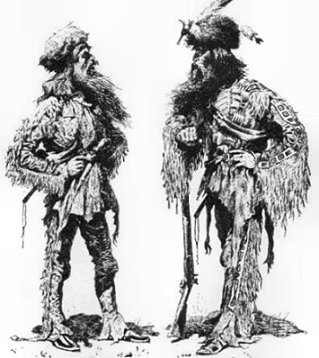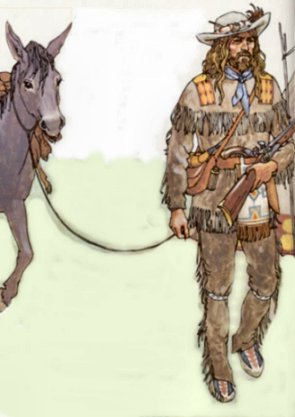MOUNTAIN
MEN
compiled by Stephenie Flora
![]()

In order to survive the harsh wilderness.
mountain men adopted the ways of the
Indians as shown in this painting by
Frederic Remington entitled
"I Took Ye For An Indian"
The mountain men became a legend in their own
time. Dime novels about their adventures became standard fare in
the east where their reputations as invincible heros grew with every
story told. In order to survive the harsh wilderness in which
they resided they adopted the ways of the Indians. Most were
solitary individuals and even many of those who worked in brigades or
with partners had an "every man for himself" attitude. Their skin
was browned from the sun and the elements and not unlike leather;
their clothing was made of the skins
of whatever animal was available. The work was hard and the
dangers many. So hard was the mountain man's life that he often
bought an Indian wife to help him, paying as much as two horses for
her, or six pounds of beads, or if she was a chief's daughter, perhaps
$2,000 worth of furs. This expense was best handled by the "free
trapper", who owned his own equipment and sold his pelts wherever he
chose, rather than the "hired hand" trapper who worked for the
fur companys and was given horse and traps and paid a fixed price for
his skins. The bride found such a match prestigious--from then on
she rose high in her tribe's esteem. She also received gifts of
jewelry, bangles, cloth, ribbon and, equally important, modern utensils
such as metal cooking pans.
The mountain man traps from the spring thaw to midsummer, when the
beavers molt, and again in autumn until the water freezes. He
camps in sheltered groves close to his traps and moves his home almost
weekly to new beaver runs. His tepee is a cover of buffalo hides
stitched with sinews and wrapped around a conical frame of poles,
slightly tilted for more rear headroom. The cover is pegged down
and closed with lodge pins except for an entrance hole with a door
flap. With smoke flaps for ventilation, the tepee is cool in
summer and, facing away from gales, is windproof in winter. In
November the fire is moved inside, and buffalo robes help to keep the
trapper and his wife warm. During the winter when trapping was
almost impossible, the trapper often wintered in the Indian village of
his wife's people. Some trappers spent their time gathering at
the various forts in their area to share stories and wait out the
winter with other trappers.
Although the standard image of the mountain man depicted him as
illiterate, there were many who were well educated.
Jedediah Smith, one of the more famous of the mountain men was well
read. He was also a religious man and never went
anywhere without his bible. Many of these men wrote legal
documents and letters for those who were not able to do so themselves.
As the mountain man moved deep into new territories, he explored and
discovered new trails and improved those previously made by the
indians.
They brought news of the new lands to the east. In the early
1840s the market for furs had deteriorated and the mountain man found
himself adrift in a new world. Settlers were moving westward in
search of land and his way of life was seriously
threatened. Some of these men continued to seek out
desolate locations away from the crowds. It was all they knew and they
could not adapt to the new world. Others went to live with
the Indian tribes of their wives. And some, hired out to wagon
trains as
guides. Many moved to areas where they had lived as trappers,
took up land and became ranchers, farmers and business men.
The
Trapper

Illustration by David K. Stone
presented in Story of the Great American West,
Readers Digest Association, IN, Pleasantville, NY 1977
![]()
My name is Stephenie Flora. Thanks for
stopping by.
Return to [
Home Page ]
All [ Comments
and Inquiries ] are welcome.